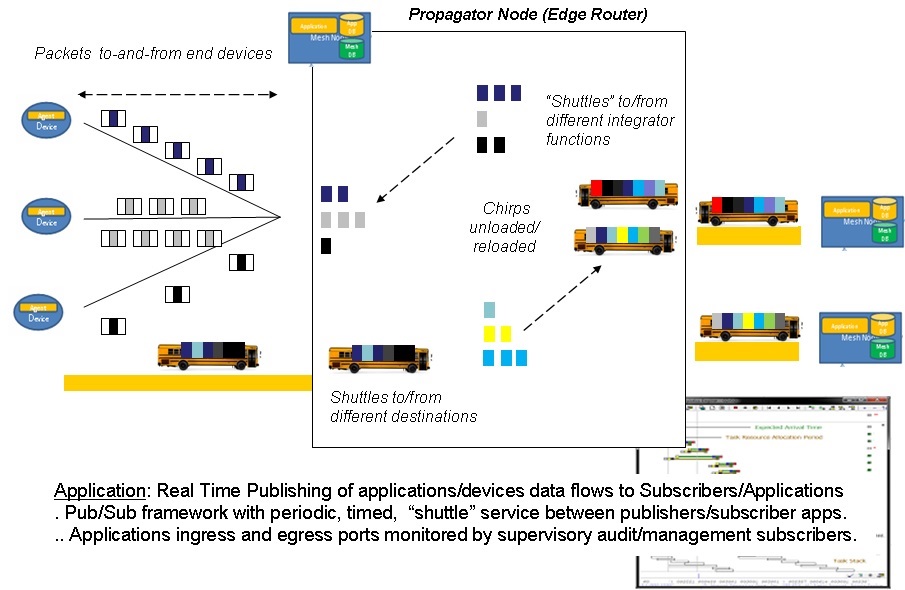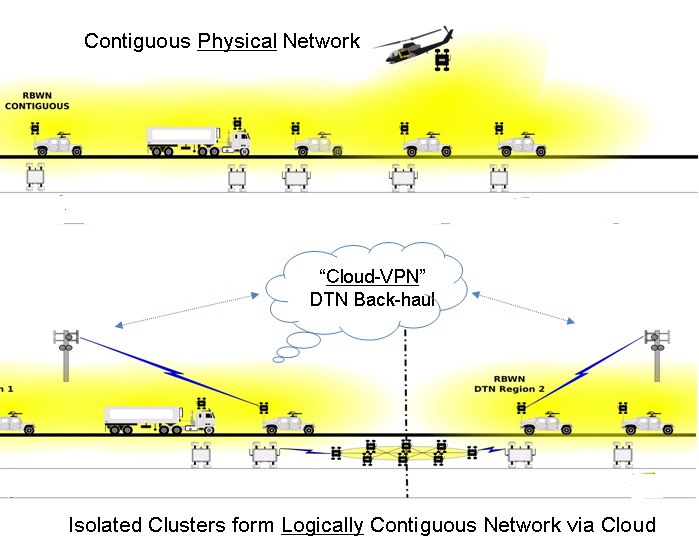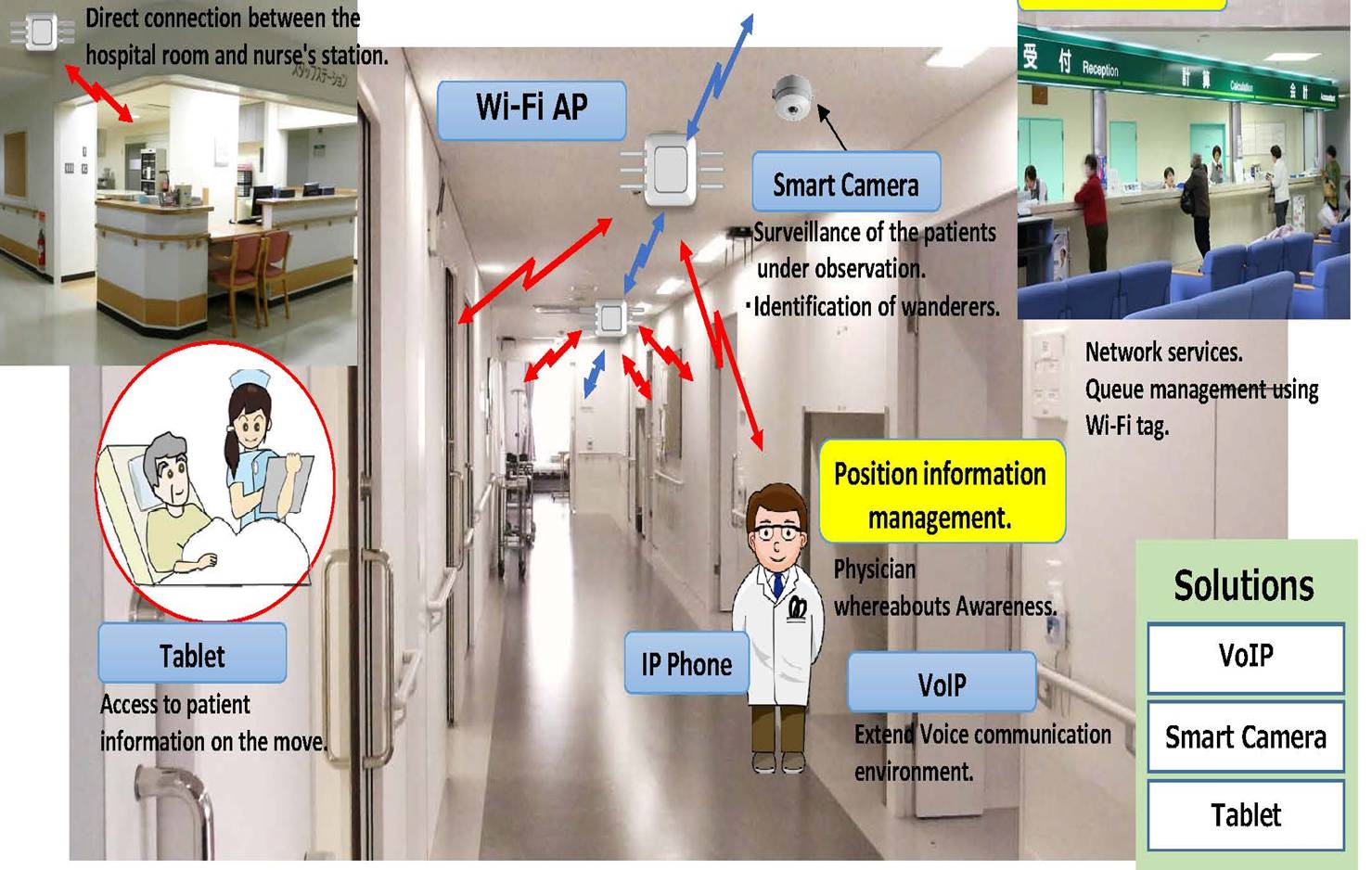 Introduction
to Software Driven Mesh TM
Introduction
to Software Driven Mesh TM
Widespread adoption of TCI/IP protocols over the last two decades appears on the
surface to have created a
lingua franca for computer networking. And with
the emergence of IPv6 removing the addressing restrictions of earlier versions,
it would appear that now every device in the world may easily be connected with
a common protocol.
But three emerging factors are requiring a fresh look at this worldview.
The first is the coming wave of sensors, actuators, and devices making up the
Internet of Things (IOT). Although not yet widely recognized, it is beginning to
be understood that a majority of these devices will be too small, too cheap, too
dumb, and too copious to run the hegemonic IPv6 protocol. Instead, much simpler
protocols will predominate (see below), which must somehow be incorporated into
the IP networks of Enterprises and the Internet.
At the other end of the scale from these tiny devices are huge Enterprise
networks, increasing movingly to the cloud for computing and communication
resources. An important requirement of these Enterprises is the capacity to
manage, control, and tune their networks using a variety of
Software
Defined Networking (SDN) technologies and protocols. These depend on
computing resource at the edges of the network to manage the interactions.
The third factor is somewhat hidden from view, but will become more important as
Enterprises seek to truly incorporate all the data from every kind of “thing.”
There are millions of legacy
machine-to-machine
(M2M) networks operating everything from robotic assembly lines to process
control facilities. These run on idiosyncratic older protocols that are often
implemented on purpose-built
Programmable Logic Controllers
(PLC). Although these M2M networks have long existed as independent islands,
increasingly Enterprises wish to pull these into a broader IoT strategy. But
these legacy networks were often designed with no thought to wider communication
and management and demand local control and response.
Concomitantly, any solution addressing these three factors must also be
exceptionally tolerant of disruption, mobility and change. Enterprises placing
“more eggs in one basket” will require that all data operation continue despite
perturbations.
 1. The Abstracted
(Software Driven ) Mesh Network
1. The Abstracted
(Software Driven ) Mesh Network

Fig 1. The Abstracted Network emulates machine specific protocols within a
(Scalable) SDN aware Fabric
Enlarge
The solution to these seemingly contradictory requirements is
an idea that is simple in concept, but demanding in implementation: The
Abstracted Network. Conceptually, the Meshdynamics Abstracted Network replaces
topologically independent networks with a single network made up of a new class
of devices called propagators.
As seen in Figure 1 , traditional networks are still often separate
today based on whether they are handling human-oriented traffic (smart phones,
tablets, computers, etc.) or M2M traffic (sensors, actuators, robots, etc.). In
some cases, such as shop floor environments, legacy protocols and response
requirements may even have kept these devices as “islands” or “silos”
disconnected from the rest of the Enterprise. These isolated networks have
remained despite the rise of IP because of simplicity of the end devices or
their peculiar communications and control requirements.
Besides the obvious networking inefficiencies, these isolated networks may
not be managed and tuned via SDN techniques. More importantly, potentially
important data flows and status indications are hidden from the primary Big Data
servers managing the rest of the Enterprise’s business. Indeed, the potential
power of the publish/discover/subscribe model for integrating IOT and legacy
traffic into business intelligence processes is the leading benefit of the
Abstracted Network concept.
The Abstracted Network model is based on Meshdynamics propagator node
communications devices (blue rectangles in Figure 1) that take advantage of
processing power and memory density advancements as well as exploiting emerging
Open Source operating systems and communications protocols. Propagator nodes
emulate the previously separate networks’ protocols, timing, and control
interactions such that legacy and IOT devices need not incorporate higher
level-protocols themselves but may still become part of the overall Enterprise
operational structure.
The underlying technology making Meshdynamics Abstracted Networks possible
is a sophisticated real-time database that creates a model of the logical
network connections and requirements. A variety of internal processes
monitor and update this model based on network traffic flows to create an
efficient virtual network structure no matter what the physical topology may be.
This includes such details as latency, protocol translation, multicast pruning
and forwarding, and even control loop management. Critically, as this Abstracted
Network model is autonomously constructed, it may then be further refined,
restructured, monitored, and tuned by the Enterprise using SDN techniques and
protocols.
This is accomplished in two ways.
First, internal processes maintain deterministic performance between different
network applications through a variety of scheduling and modeling algorithms
within the propagator node network itself. This is part of the Meshdynamics mesh
network framework. Secondly, applications agents onboard each of the propagator nodes may
participate with Enterprise-wide SDN messaging to optimize network performance
based on rules and other parameters.
Physically, propagator nodes
may incorporate a wide variety of wired and wireless interfaces to facilitate
connection to many legacy and IOT devices As discussed below for the simplest
IOT devices, propagator nodes permit publish/subscribe data flows even for the
simplest or proprietary devices. Similarly, a variety of network connections may be used as links
between propagator nodes themselves, the traditional Internet, and Big Data
integrators. More
 2. Disruption
tolerance, mobility, and changeability
2. Disruption
tolerance, mobility, and changeability

Fig. 2 Disruption tolerance between nodes is provided
an adjacency database and routing table exchanges
With “more eggs in one basket”, survivability and non-stop operation of the
Abstracted Network becomes vitally important. But because the interconnected
propagators maintain databases for both their own topology and for the logical
network configuration, disruption tolerance is provided inherently. As a first
level of disruption tolerance, the propagator network maintains awareness of
adjacent nodes and alternate paths, automatically making use of the best links
as primary connections and maintaining awareness of any changes or failures.
This allows near-instantaneous re-routing around failures.
More.
A by-product of this capability, propagator nodes may be in motion
relative to one another, and to end devices.
More.
Because the internal database of node adjacencies and link qualities is
constantly updated, individual nodes may shift to new connections as old ones
are fading, maintaining network operation. Disruption tolerance also extends to
individual applications and families of connected devices.
The applications
agents in each propagator node may be equipped with software that actually
performs many functions on behalf of connected devices such as data collection,
alarms and status, control loop management, even spoofing of network
acknowledgement and requests. This may be maintained through a complete failure
of the upstream connection and interruption of round-trip communications – the
propagator node keeps the local operation intact until the upstream connection
is restored.
The capabilities of the propagator node and the Abstracted Network Concept will
be especially important for integrating the coming explosion of Internet of
Things devices and their terse M2M communications schemes, discussed
below.
 3. Publish,
Subscribe and Discovery for the Edge
3. Publish,
Subscribe and Discovery for the Edge

Fig 3: Applications Subscribe to Aggregation, Pruning Services and
other Real Time Pub/Sub M2M
“Shuttles” Enlarge
The Abstracted Networks concept has one basic
premise: If simple edge devices aren't capable of deep protocol
intelligence, it must reside somewhere and operate on behalf of the end devices.
The major elements of that somewhere are the Level II Propagator nodes
As introduced above, these are like familiar networking equipment such as
routers and access points, but they operate in a different way in with IOT and
legacy devices. To explore the functions of the propagator nodes in more detail, we can
examine their function in an IOT application – but of course this may be
extended to legacy and IP networking as well.
Propagators listen for data "chirping" from any device. Based on a simple
set of “markers” in the chirps (described below), propagator nodes decide how to
broadcast these chirps to other propagator nodes and on to the higher-level
Integrator
(Big Data) subscribers. In order to scale to the immense size of
the Internet of Things, these propagator nodes must be capable of a great deal
of discovery.
They must recognize other propagator nodes within range, set up simple routing
tables of adjacencies, and discover likely paths to the appropriate integrators.
(The key is building a logical tree-like topology from physically meshed
propagators. The topology algorithms have been tested and described
here)
Typical applications on Propagator nodes serve as aggregation, pruning and If-this-then-that filters.
They organically form “hubs”, similar to bus terminals along commonly used
routes. M2M "Chirps"
passing from-and-to end devices may be combined with other traffic for
forwarding. Applications provide this networking on behalf of devices and
integrators at levels "above" and "below" themselves within
their hierarchy in a tree based framework.
More.
Any of the standard networking protocols may be used, and
propagator nodes will perform important translation functions between different
networks (Bluetooth to Wi-Fi, for example), essentially
creating small data “flows” from M2M chirp data streams. Other trusted applications and agents, many residing inside the
Propagators, coordinate the function and control of dumb small, cheap, and
copious IOT devices through Software Defined Networking (SDN) paradigms for the
edge.
 4.
Autonomous Industrial IOT Network Implementation (SPAWAR)
4.
Autonomous Industrial IOT Network Implementation (SPAWAR)

Fig 4: Disruption
Tolerant, Semi-autonomous networks (SPAWAR)
Meshdynamics has been developing an open-source propagator platform for
disruption tolerant networking for the US Navy and US Department of Energy.
Propagator nodes support User Space Application Layer within an
OpenWRT
architecture for deep packet inspection, SDN based routing, Video, IFTTT
(conditional “If This Then That” rules), etc. These propagator nodes provide
autonomous, robust machine control with no assurance of internet connectivity
through the built-in applications agents.
Nearly everything described above takes place autonomously and automatically
within the Disruption Tolerant Mesh Network.
Propagators and their applications even route
around failures of links or nodes and deal with issues created by mobility of
network elements. But some of the most important capabilities of propagators are
distributed application intelligence agents that can allow higher level
functions to “tune” the propagator network as part of an overall
publication/discover/subscribe infrastructure and/or create application
instantiations (e.g. machine controllers) within the nodes themselves. These
permit connected devices to continue to operate when the broader network
connection is lost. [More]
The end result is a Publish/Subscribe (Pub Sub) network that can be
extended from Big Data servers all the way to the edge of the network while
still maintaining a degree of responsive local autonomy. A variety of standards-
based SDN protocols may be implemented on the distributed applications agents.
"Meshdynamics Scalable and Open Pub Sub enables us to rapidly integrate
with Enterprise Class, OMG (Object Management Group)-approved, industry-
standard messaging systems from RTI (Real-Time Innovations), PRISMTECH, OpenDDS,
and others to provide assured real time end to end performance, even if we scale
to billions of devices at the edge.”
Curtis Wright, Sr. Research
Systems Engineer,
Space and Navy Warfare Center.
 5.
"Smart Enterprise" Network
Implementation (SHARP)
5.
"Smart Enterprise" Network
Implementation (SHARP)

Fig. 5: “Smart”
Networks supporting Real time Situation Assessment via multiple tracking
devices (SHARP)
Along with the ability to manage change and disruption, the unique multi- radio
architecture for propagator nodes allows the extension of the network along many
“hops” (node-to-node links) without additional wired connections. This “string
of pearls” capability allows large outdoor and indoor "tunnels" to be connected as well
as extending services to new remote locations at the next "edge".
These extended propagator node
links are simply treated as another element of the Abstracted Network and may be
managed by Enterprise SDN tools and techniques. The Meshdynamics mesh network
fabric observes and
accommodates the additional delays experienced by traffic traversing long strings
of propagator nodes with minimal additional latency or jitter compared to other
network connections.
Propagator nodes also act as traditional switches or routers for IP traffic,
while translating and packaging chirp and legacy traffic into IP packets for
forwarding. Because the propagator nodes incorporate both chirp-based and
traditional protocols, they are the natural point of integration for emerging
IOT, legacy, and IP networks.
in 2015,
Sharp Corporation announced the
QXC300
series of modular networking devices that acts as a traditional meshed Access
Point to provide connectivity for conventional IoT sensors like
cameras -
and
Sub
1GHz radios for chirp networks.
“Meshdynamics’ propagator node software allows us to deploy WiFi
networks today with minimal additional wiring and also incorporate emerging
Internet of Things devices on the same infrastructure today and in the future.”
Mr. Arai Yuji, GM, Communication Division,
Sharp Electronics, Japan.
 Summary
Summary
Far from being a homogenous computing and networking environment, the next
generation of Enterprise communications will actually require the integration of
an even wider variety of protocols and devices as legacy and IOT applications
are finally incorporated into the Enterprise network. Conversely, Enterprises
will wish to extend their Software Defined Networking capabilities to encompass
these “things” at the edge.
For Industrial IOT in particular, the future world of small, dumb, cheap, and copious
sensors, actuators, and devices demands rethinking at both ends of the scale. At
the far reaches of the network, simplified chirp based M2M protocols will minimize lifetime costs
for the myriad end points of the Internet of Things.
At the same time, the concept of Abstracted Networks and powerful networking and
applications tools concentrated in propagator node devices will allow
unprecedented control and flexibility in creating huge Enterprise networks of
diverse elements by extending industry-standard SDN tools and techniques.
Fully exploiting the power of the Internet of Things will grow from a total
rethinking of network architectures.
 About Francis
daCosta
About Francis
daCosta
The emerging Internet of Things architectural concepts and
Meshdynamics wireless mesh networking propagator technology has been influenced by the
Robotics and Machine Control background of founder
Francis daCosta - early mesh nodes were installed on robots. Francis previously founded
Advanced Cybernetics Group, providing robot
control system software for mission critical applications, mandating real time
sensor guided control and both local and supervisory control loops.
At MITRE, he served as an
advisor to the United States Air Force Robotics and Automation Center of
Excellence (RACE). In 2012, Intel sponsored
Francis’ book Rethinking the Internet Of Things, a finalist for 2014
Dr. Dobbs
Jolt Award.
 Blog Links
Rethinking Tree Topologies Self Classification With Chirps
Smarter Simulations
Blog Links
Rethinking Tree Topologies Self Classification With Chirps
Smarter Simulations




